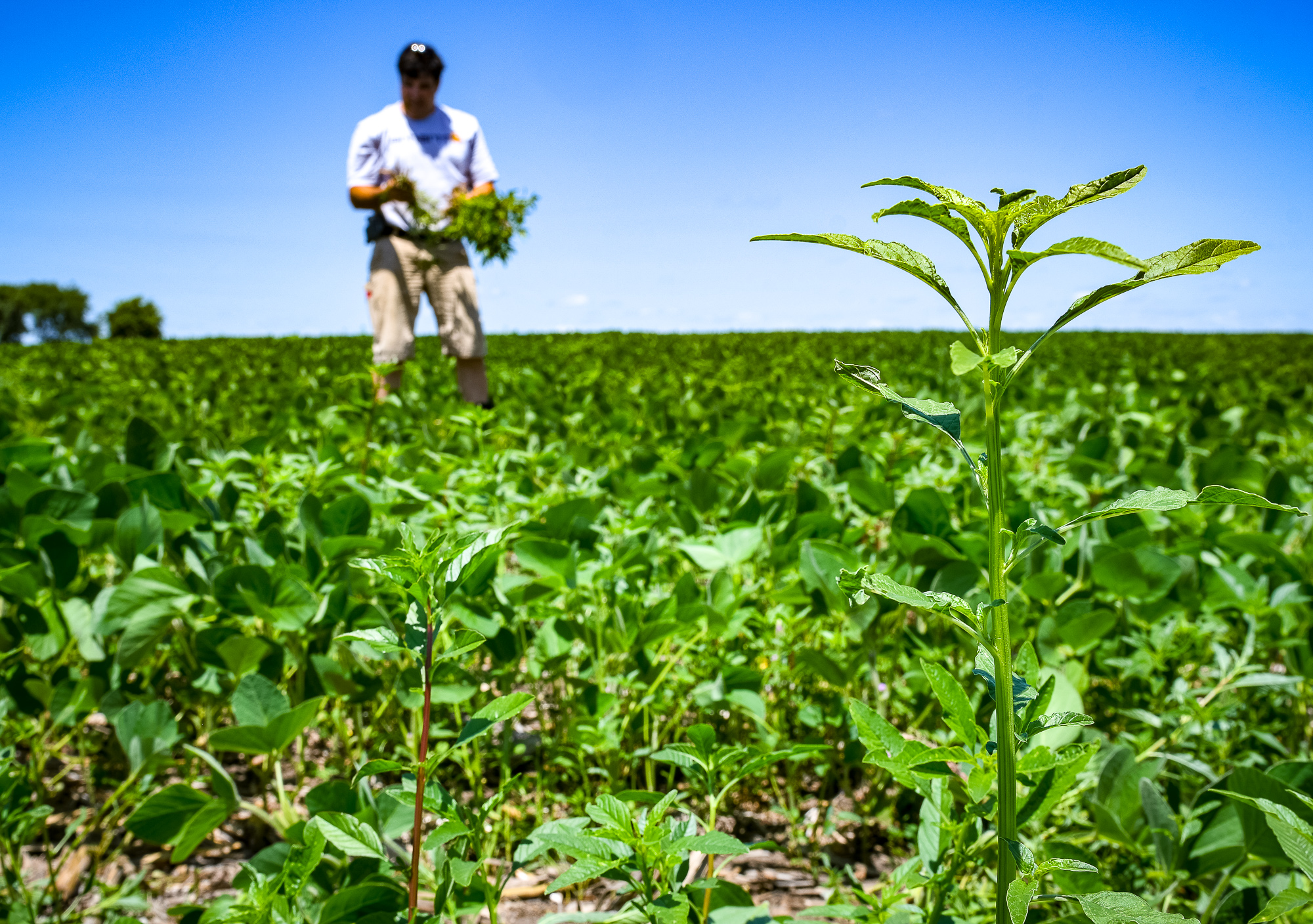
Checkoff funding is being utilized to research pest and weed resistance that impact yields. (Photo: Joseph L. Murphy/Iowa Soybean Association)
ISA all-in on pest resistance management program
February 18, 2021 | Bethany Baratta
Seven years ago, the Iowa Department of Ag and Land Stewardship (IDALS) and Iowa State University’s College of Agriculture and Life Sciences facilitated a meeting centered around the impacts of pesticide-resistant pests on agronomic practices.
Planning for the workshop included input from Iowa farm organizations (including Iowa Soybean Association), cooperatives, agricultural retailers, certified crop advisors, independent crop advisors, land management firms, and pesticide companies.
The 75 people in attendance talked about the emergence of resistant pests in Iowa, the strategies and approaches available to address resistance management and the role members of the agriculture community could play in addressing those concerns.
What came out of the meeting was the Iowa Pest Resistance Management Plan, designed to establish a unified, consistent message to increase awareness for action.
The plan expanded into the Iowa Pest Resistance Management Program (IPRMP), an Iowa-specific effort to address pests--including weeds, insects and diseases--that can adapt and become resistant to chemical, genetic, and agronomic control practices.
“Ultimately we’re trying to raise awareness that pest resistance is here. We need to manage it, deal with it, and spread the word not only on the county level, but in the state and across the nation,” said Larry Buss, a Harrison County farmer. Buss talked about the program during an episode of CropsTV. This online program replaced the popular Integrated Crop Management Conference and Crop Advantage Series this winter. It was sponsored in-part by the Iowa Soybean Association.
Buss began leading efforts in Harrison County, where he discovered Palmer amaranth in 2015. The county was picked to as a location for a pilot project in 2017.
“Our aim is to involve the entire community,” Buss said. “This isn’t just a farmer-landowner problem. To solve it, you have to have the entire community—agronomists, lenders, experts.”
There has even been dialogue with the Environmental Protection Agency (EPA) about new product registrations.
A survey of farmers in the county found weed resistance to be one of the greatest challenges, said Mike Witt, a field agronomist for Iowa State University.
At the top of the list: waterhemp and marestail.
“The issue wasn’t necessarily the cost or timely applications,” Witt said. “Resistance was the main driver in everyone’s minds.”
A follow-up with farmers discovered that 20 to 25% were doing a 3-pass application to control weeds in their soybean fields. ISU field studies in Harrison County in 2019 confirmed resistance to various herbicides. It drove the point home to farmers that resistance was happening in their community, and, in some cases, in their own fields, Witt said.
“We know herbicide resistance isn’t just a Harrison county issue; however, this group is very unique in that we want to help the community. We want people to see what’s going on,” Witt said.
The group has inspired others, like Tim Couser in Story County to raise awareness in their own communities.
“We need to keep educated on how important chemistries are and lengthen out the longevity of them before they become resistant,” Couser said. He’s part of the Story County Farm Resistance Network.
“We feel it’s important to gather as group and demonstrate the importance of weed resistance management to make sure these chemistries are useful in the future,” Couser said.
ISA approach
The Iowa Soybean Association (ISA) was a part of that meeting 7 years ago when the plan was established. ISA, a charter member of the program, wants farmers to be able to access the tools and technologies to keep them profitable and productive. That’s been a key component of ISA’s work since it was founded by farmers for farmers in 1964. That’s why ISA champions the mission of the Iowa Pest Resistance Management Program.
“It’s always been and will continue to be such an integral part of every plan we do at ISA as we’re constantly trying to remind our farmers of the big picture,” said Ed Anderson, senior director of research at ISA. “We want to raise awareness, provide options, and help farmers across the state understand what integrated management solutions are best for managing weeds, diseases and insects.”
Checkoff support provides opportunities for ISA to dig deeper into production challenges to find potential solutions, he says.
“There’s always checkoff support going into novel, innovative ways that are not just herbicides or biotech traits or traditional ways of managing whatever pest but looking at innovative solutions to extend the life of those and provide new ways for farmers to meet these production challenges,” Anderson said.
One such example is weed management.
Through its membership of the North Central Soybean Research Program, checkoff dollars are supporting work in identifying alternative ways to manage weeds through seed destruction equipment and practices and the electrocution of weeds above the canopy. Learn more by visiting the database.
Another research project is exploring how cover crops can fit into an integrated cropping system. Do cover crops positively or negatively affect weed management? What about insect pests and diseases? How can farmers use cover crops in helping to suppress weeds from germinating so we can help manage the overall weed population?
Dive into more ISA research offerings in two upcoming webinars on March 9 and March 11.
Register Now
Back